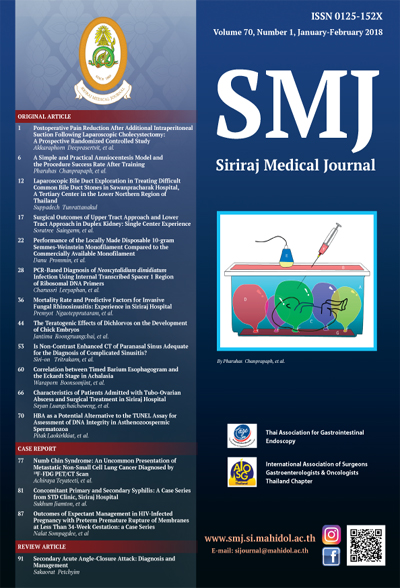The Teratogenic Effects of Dichlorvos on the Development of Chick Embryos
Keywords:
Dichlorvos; organophosphate; teratogen; chick embryoAbstract
Objective: The purpose of this study was to elucidate the teratogenic effects of dichlorvos on developing chick embryos.
Methods: The fertilized Leghorn hen eggs were divided into two groups: the experimental group which was injected with 0.1 ml of 0.5% and 1% dichlorvos in normal saline and the control group which was injected with 0.1 ml of normal saline after 21 h of incubation. On day 3, 6, and 11, the embryos were collected for studying embryonic dead and abnormalities.
Results: The results showed that the mortality rate increased with the increasing concentration of dichlorvos and time of incubation. The total mount of day 3 had only three primary brain vesicles, small and retarded primordial eye, dilated U-shaped heart looping, bifurcation of spinal cord and trunk when compared with the control. The results in the serial section of day 3 and 6 showed several abnormalities especially the retardation of eye and heart. Day 11 embryo revealed morphological anomalies including hematoma and bone deformation.
Conclusion: Dichlorvos caused congenital abnormalities in chick embryos in 3 categories, the growth retardation, the malformations and the embryonic death which were predicted to cause the same results in contaminated humans. Dichlorvos exposure increases the risk of malformations and embryonic death. The present study revealed that dichlorvos was a powerful teratogenic compound and therefore its use should be limited and pregnant women should avoid contamination with dichlorvos especially in the first trimester.
Downloads
Published
How to Cite
Issue
Section
License
Authors who publish with this journal agree to the following conditions:
Copyright Transfer
In submitting a manuscript, the authors acknowledge that the work will become the copyrighted property of Siriraj Medical Journal upon publication.
License
Articles are licensed under a Creative Commons Attribution-NonCommercial-NoDerivatives 4.0 International License (CC BY-NC-ND 4.0). This license allows for the sharing of the work for non-commercial purposes with proper attribution to the authors and the journal. However, it does not permit modifications or the creation of derivative works.
Sharing and Access
Authors are encouraged to share their article on their personal or institutional websites and through other non-commercial platforms. Doing so can increase readership and citations.











